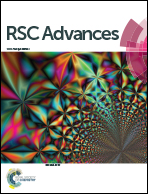An ultrasensitive electrochemical immunosensor for the detection of human immunoglobulin G based on Ag@BSA microspheres†
Abstract
A novel human immunoglobulin G (HIgG) electrochemical immunosensor was developed based on nanosilver-doped bovine serum albumin microspheres (Ag@BSA). The immunosensor was prepared step-wise by first modifying the electrode with β-cyclodextrin functionalized gold nanoparticles followed by the immobilization of captured antibodies and then the formation of a sandwich-type immunocomplex to introduce Ag@BSA bionanoprobes on the sensor surface. The amplification pathway using the stripping voltammetric measurement of silver ions released from Ag@BSA to monitor the immunoreaction was first adopted. The immunosensor exhibited a large dynamic range of 1 fg mL−1 to 10 pg mL−1 and an ultralow detection limit of 0.5 fg mL−1 to HIgG. Moreover, the immunosensor also showed acceptable stability and reproducibility. This biosensor was applied to the detection of the HIgG level in real serum samples.


 Please wait while we load your content...
Please wait while we load your content...